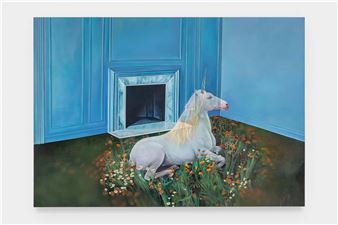Emma Webster: The Engine of Beasts
Perrotin is delighted to present Emma Webster's first solo exhibition in Paris, The Engine of Beasts. In her third show with Perrotin, Webster stages paintings alongside sculptures, so viewers may follow the representation of a beast in all its states. The guiding theme of the exhibition: The word Engine's Latin etymon, ingenium, meaning skill or ruse, also signifies the ability to move easily from one medium to another, like a life-form striving to adapt, evolve, and survive. Between the transfiguration and fictive landscapes that serve as a barrier between the characters and the viewers, Webster reveals her interest in sentience, a combination of sentiment, sensation, and conscience.
Virtual Reality? Real Virtuality: The Ruses of Emma Webster
The fox is lost in the darkness of the painting, and so are we. Something seems to catch his attention-he has just barely paused his movement. Crafty is part of a long tradition of animal painting: it is reassuring, as is the chosen technique, oil on canvas, which has been considered the most prestigious in the West for centuries. But soon various elements of this exhibition in Emmanuel Perrotin's Paris gallery begin to disturb us. Some of them are related to the paintings themselves, and others are the result of the overall exhibition design.
These paintings make us reflect on the separation between humans and animals, as with any representation of an animal, whether it feels familiar or quite distant. In Emma Webster's work, distance dominates. The animals appear solitary or in pairs within a landscape where humans have left no trace. The light is often limited, and the ground is emphasized, as with the lamb in Witness. But the very title of this painting draws our attention to another feature: the fact that the animal figure seems to perceive a presence that is invisible to us. A threatening mood recurs in these paintings, a sense that something could happen and cause physical harm.
This is true also in the way the creatures are depicted. In fact, as soon as we examine the artworks more closely, we realize that something is wrong-meaning that Western conventions are both present and challenged. The figures in the paintings are sometimes treated "realistically." Then, on the contrary, in the representation of the fox mentioned above, in Bovine Skull, and even more so in Great Poet! (which is prominently displayed in a central location in the gallery), we can clearly see that the figure is made up of a corroding ligature, or something that may be a metal structure. In any case, it is not a real body.

Recommended for you
Perrotin is delighted to present Emma Webster's first solo exhibition in Paris, The Engine of Beasts. In her third show with Perrotin, Webster stages paintings alongside sculptures, so viewers may follow the representation of a beast in all its states. The guiding theme of the exhibition: The word Engine's Latin etymon, ingenium, meaning skill or ruse, also signifies the ability to move easily from one medium to another, like a life-form striving to adapt, evolve, and survive. Between the transfiguration and fictive landscapes that serve as a barrier between the characters and the viewers, Webster reveals her interest in sentience, a combination of sentiment, sensation, and conscience.
Virtual Reality? Real Virtuality: The Ruses of Emma Webster
The fox is lost in the darkness of the painting, and so are we. Something seems to catch his attention-he has just barely paused his movement. Crafty is part of a long tradition of animal painting: it is reassuring, as is the chosen technique, oil on canvas, which has been considered the most prestigious in the West for centuries. But soon various elements of this exhibition in Emmanuel Perrotin's Paris gallery begin to disturb us. Some of them are related to the paintings themselves, and others are the result of the overall exhibition design.
These paintings make us reflect on the separation between humans and animals, as with any representation of an animal, whether it feels familiar or quite distant. In Emma Webster's work, distance dominates. The animals appear solitary or in pairs within a landscape where humans have left no trace. The light is often limited, and the ground is emphasized, as with the lamb in Witness. But the very title of this painting draws our attention to another feature: the fact that the animal figure seems to perceive a presence that is invisible to us. A threatening mood recurs in these paintings, a sense that something could happen and cause physical harm.
This is true also in the way the creatures are depicted. In fact, as soon as we examine the artworks more closely, we realize that something is wrong-meaning that Western conventions are both present and challenged. The figures in the paintings are sometimes treated "realistically." Then, on the contrary, in the representation of the fox mentioned above, in Bovine Skull, and even more so in Great Poet! (which is prominently displayed in a central location in the gallery), we can clearly see that the figure is made up of a corroding ligature, or something that may be a metal structure. In any case, it is not a real body.
Artists on show
Contact details

Related articles
Perrotin is presenting Emma Webster’s first solo exhibition in Paris, The Engine of Beasts. In her third show with Perrotin, Webster stages paintings alongside sculptures, so viewers may follow the representation of a beast in all its states.















